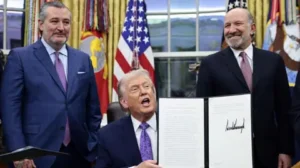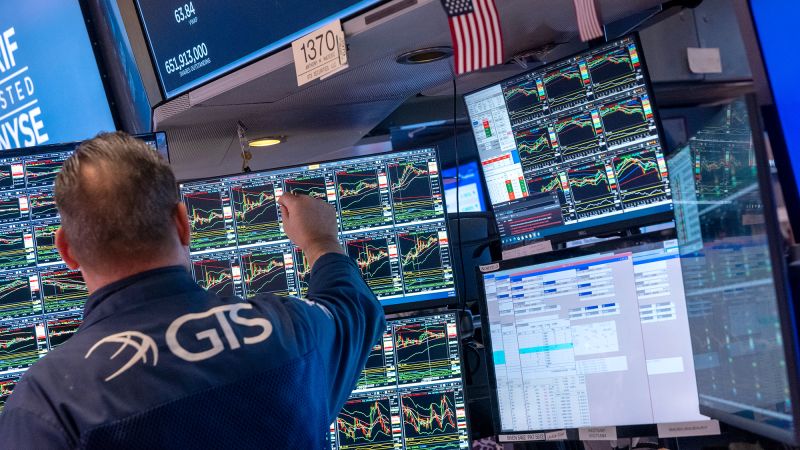The recent fluctuations in the financial markets have left many investors feeling anxious and uncertain. After witnessing significant declines over the past three trading sessions, Wall Street has been searching for signs of stability, and it appears for the time being, they have found a potential respite.
On Tuesday, futures for the Dow Jones Industrial Average surged by an impressive 1,000 points, marking an increase of approximately 2.5%. Similarly, the S&P 500 futures climbed by 2%, while the futures for the Nasdaq composite rose by 1.8%. This rebound comes after a turbulent period when stocks were adversely affected by fears surrounding President Donald Trump’s controversial tariff policies. Investors expressed concerns that these tariffs could propel both the United States and the global economies into a recession. Nonetheless, after several days of market turmoil, many investors capitalized on what they viewed as opportune buying moments.
The price-to-earnings (P/E) ratio for S&P 500 companies dipped below 17 on Monday, a level that is often considered historically low and attractive to buyers. This drop in ratio prompted some investors to begin purchasing shares that may have been oversold. Keith Lerner, a strategist at Truist, described the recent market activity as a typical response following a period of shock. “The market is extremely oversold, and markets don’t operate in a linear fashion,” Lerner commented, emphasizing the fluctuations that often accompany such market conditions.
Market rebounds frequently coincide with significant stock price declines, as traders, wary of missing out on a potential upswing, may rush to buy. Lerner further explained that during uncertain periods, fresh information tends to be overreacted to, resulting in larger-than-normal price swings. For instance, a piece of misinformation suggesting that President Trump might pause some tariffs led to a brief uptick in stock prices before being swiftly dismissed by the White House.
Michael Block of Third Seven Capital pointed out that even the prospect of favorable news, such as hints regarding a tariffs pause, can lead to rapid market rallies. Despite the false alarm, traders remain watchful for actual positive developments. However, while the market’s current bounceback offers a glimmer of hope, the overall market landscape remains precarious.
As President Trump continues to push for extensive tariffs, including steep increases of up to 50% on certain countries and potential spikes of nearly 70% on Chinese imports, there is a growing sense of unease. Trump has indicated he may implement an additional 50% tariff on China should that nation not retract its retaliatory measures. The threat of further escalation in trade tensions raises the specter of a possible recession, a sentiment echoed by analysts at major financial institutions such as Goldman Sachs and JPMorgan Chase.
Despite the current optimism surrounding the market’s rebound, some officials within the Trump administration declared victory prematurely. Peter Navarro, Trump’s chief trade advisor, made a bold claim on Fox News, asserting that the market is now “finding the bottom,” and predicting a significant recovery ahead – even projecting the Dow Jones to reach an unprecedented 50,000.
However, contrasting perspectives surfaced from influential business figures like Jamie Dimon, CEO of JPMorgan Chase, who cautioned against the risks associated with ongoing tariff conflicts. He warned that these trade policies could lead to increased prices, slowed economic growth, and a deterioration of America’s international alliances. Notably, even some of Trump’s notable supporters, such as Elon Musk and Bill Ackman, have voiced strong objections to the flawed logic behind implementing tariffs.
In global markets, mixed signals emerged as stocks across several regions rose on Tuesday. Japan’s Nikkei 225, which represents more than 200 of the largest companies in the country, surged by 6%. Similarly, South Korea’s Kospi index gained 0.3%, while Australia’s ASX 200 index climbed 2.3%. Following a significant drop exceeding 13% the previous day—the largest since the Asian financial crisis in 1997—the Hong Kong Hang Seng Index finished about 1.5% higher.
In Europe, the overall sentiment remained positive, with the STOXX 600 index showing an increase of 1.4%. France’s CAC 40 index saw a rise of 1.6%, while Germany’s DAX climbed by 1.3%, and the UK’s FTSE 100 experienced a gain of 1.9%. Overall, the recent stock market fluctuations underscore the ongoing volatility and the potential for both recovery and further downturns as the global economy grapples with significant political and economic pressures.











